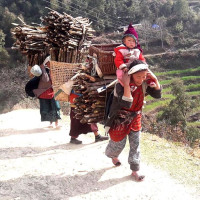- Saturday, 27 December 2025
Traditional swings disappearing from villages
By Amar Raj Naharki,Tanahun, Oct. 18: The traditional practice of playing various types of swings, a cultural pastime of Nepali people during Dashain, Tihar, is gradually fading.
In recent years, swings like linge, jate, and rogate have become a rare sight in the villages of Tanahun.
Despite efforts by local governments, social organisations and youth clubs to preserve this tradition, modernity has caused a shift in attention. Elderly people say that children are more absorbed in mobile phones than enjoying swings, reducing the significance of this cultural practice.
Elderly villagers blamed swing culture's decline due to increased modernisation and the younger generation's migration to cities and abroad. Swings used to be set up at the start of Dashain and remained in place until Tihar.
Khadananda Kaini, 82, from Byas Municipality-11, Polyang, recalled that swings, once common in every village square, are now rarely seen.
“Until a few years ago, there would be swings all around the village during Dashain, but now it’s hard to find even a single linge, jate and rogate ping.”
The old tradition of swinging during Dashain is now seen in rural areas only occasionally. When Dashain arrived, youth used to gather in villages to collect babiyo, grass used to make rope, and bamboo to build swings, which were mandatory as per the belief that everyone, from children to the elderly, must “leave the ground” on Dashain Tika day.
During Dashain, it used to be a tradition for the village youth to build linge pings for children to play and enjoy, but this enthusiasm is no longer seen in the current generation. In the past, a small amount of money was collected from each household to gather bamboo, ropes, and wooden materials. The swing, created through the collective effort of everyone, was considered as important as a village treasure.
In some places, swings can still be found, but they are often made with ropes and poles purchased from the market. Traditionally, ropes would be hung from bamboo poles to create the swings. There was a longstanding custom that everyone, from children to the elderly, had to play on a swing at least once a year, according to the elders.
Rote, jate and linge pings were built only during special festivals. Their rarity preserved their cultural significance. The linge ping was made by erecting bamboo poles in four directions and using ropes made from babiyo grass. While people of all ages would play on the swings, it was the youth who were most excited about it.
Tara Prasad Panta, President of Ekata Youth Club in Kamalbari, Byas Municipality-12, said, “In the past, people would wait in long lines just to get a turn on the swing, competing to see who could swing the highest, but now this has disappeared.”
Panta said that the club has been building swings to help the new generation learn about this fading cultural practice. He believed that swings promote social unity and harmony, which is why the club sets up a swing every year.
With technological advancements, there are now plenty of other entertainment options, which has lessened the attraction to swings, according to Panta. He added that because many youths have gone abroad for employment, there are not enough people left to build swings, resulting in their disappearance.
“Instead of playing on swings in the field, the youth prefer to stay indoors playing games on their mobiles and laptops, spending their time on TikTok, Facebook, and YouTube,” Panta said.





-square-thumb.jpg)










